Attraction spotlight: the mystical site of Delphi, Greece
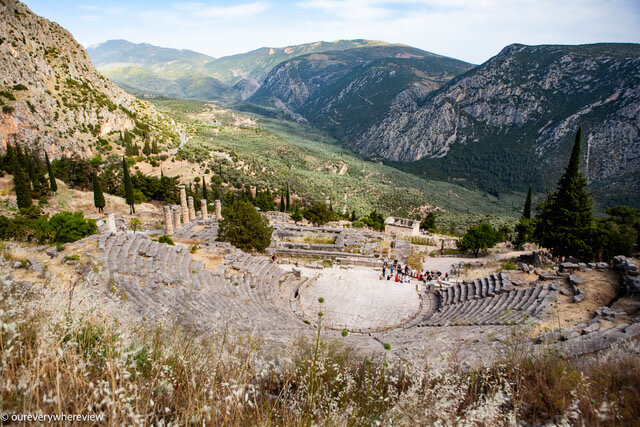
Delphi was a prominent religious sanctuary to the ancient Greeks, perhaps second only in importance to Athens. Built in the 8th century BC, sacred to Apollo, the Olympian God of light, knowledge, truth, music, and… well, practically everything. As mythology goes, to determine the location of this important site, Zeus released two eagles, one flying West and one flying East. Their meeting point became Delphi, known then as “omphalos” (Greek for “navel”), the centre of the World. It was home to Apollo’s oracle, a middle-aged priestess who delivered prophecies to Kings and pilgrims from all over the world. Delphi was one of the most revered and most powerful spots in the ancient world, and is now a UNSECO world heritage site.
I had to admit, as a scientist, the entire thing seemed a little bit voodoo, a bit of a spectacle. Visiting Delphi, I did not feel the mystical and deep spiritual connection the ancient site is supposed to evoke. But that is okay. You do not need to fall in love with every place you visit. Delphi is a site steeped in history and rich in storytelling. And the view? Well, the stunning view just lends a little bit more magic.
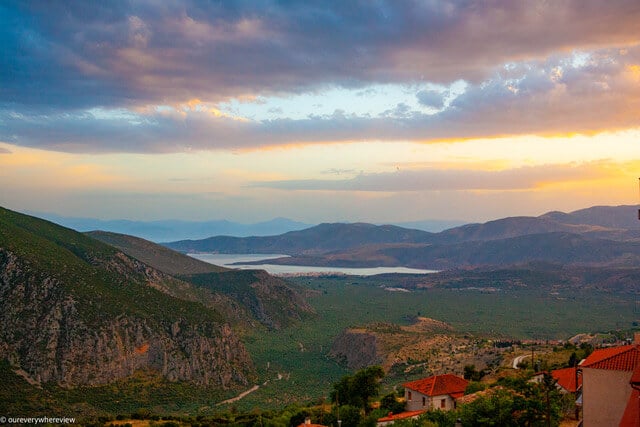
The story of the Oracle
The Priestess (the Pythia)
The power of Delphi comes from the Oracle. She was a priestess, always middle-aged or older, selected from the nearby population. She would prophesy from the Temple of Apollo, within an inner adyton (restricted sanctuary) on a tripod over a chasm. Legend goes that when Apollo slew Python, his body fell into this chasm. The resulting fumes caused the Oracles to fall into a trace, and Apollo himself would speak through her. (Coincidentally, there *are* fault lines in the area, which do emit mind-altering fumes.) The Oracle then “raved” in this state, delivering unintelligible speak which the priests interpreted.
The Oracle held a position of massive influence in the ancient world. Delphi became a powerful city-state. At the height of Delphi, there were up to three rotating priestesses that delivered prophecies. The Oracles was consulted on all matters of state, including war and colonization. She advised everyone from the famous Alexander the Great and Socrates, to the average Greek asking for marriage advice.
The prophecies
These prophecies were purported to be tricky to interpret. They were delivered purposely as something of a riddle, and the conclusion drawn probably speaks more to the seeker than to the Oracle. As the story goes, one of the most famous prophecies was in response to Croesus (the King of Lydia, in the area of modern day Turkey). In the face of increasing Persian influence, he asked the Oracle, “should I go to war with the Persians?” To which the Oracle responded, “if Croesus goes to war, he will destroy a great empire.” And so Croesus led his men into war against his counsel’s advice, believing he was destined to win. As it turned out, it was his *own* empire that was destroyed.
For nearly a thousand years, Delphi was truly the “centre of the world”. From the 5th century BC onwards, nations fought over the site, and Delphi exchanged hands a number of times. Finally, the Byzantine emperor Theodosius outlawed all pagan beliefs and rituals. The temple of Apollo and almost all of Delphi was subsequently destroyed in the AD 300s.
The practicalities of visiting Delphi
Getting to Delphi
Delphi tends to be high on most traveler’s lists. It is the top booked day tour out of Athens.
As with most sightseeing in Greece, we recommend to go it on your own, if possible. With ancient sites like these, it really relies on the setting and the mood to experience the sites as they were. Being able to avoid the majority of the crowds and exploring Delphi at your own pace is worth the added effort.
There are public city buses (KTEL) that run from Athens to Delphi. This will take about 3 hours. (And the station is in the northern part of Athens, which likely means you will need to take the metro to get there.)
Our suggested option is renting a car. (There are many rental agencies in downtown Athens for day rentals… but getting your car out of Athens may be an adventure! Getting used to driving a manual and stalling on one of Athens’ busy intersections? Not fun. We might know from experience… :P) If you don’t want to drive, you can also choose to hire a private transfer or private taxi. Just book ahead with any of the main taxi companies. Driving takes about 2-2.5 hours.
We came in to Delphi from Olympia. It was about a 3hr drive, along the Gulf or Corinth. (And what a stunning drive!) It was fascinating to see the landscape change as we neared Delphi, becoming drier, with a red rock and soil typical of that area.
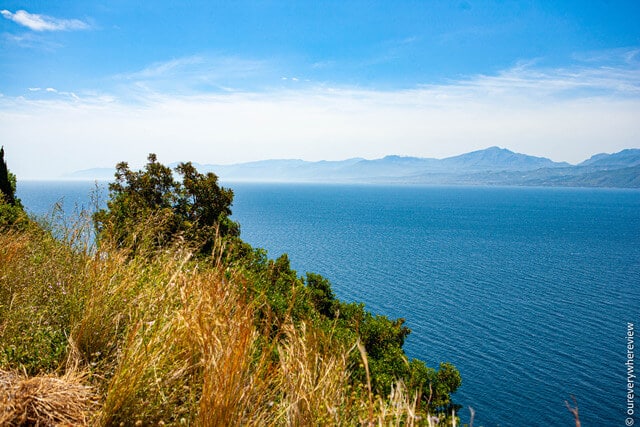
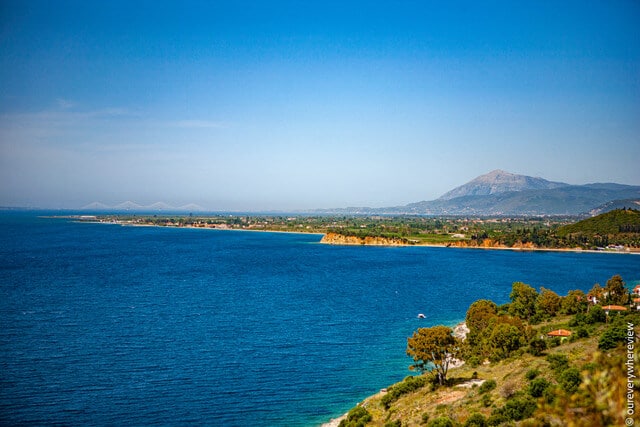
Overnight in Delphi?
If you are based in Athens, we absolutely recommend sticking with a day trip into Delphi. Besides the archeological site, there is not much to do or see in the area.
Unlike towns such as Olympia, the modern town of Delphi was not necessarily built for tourists. The residents were relocated from the actual archeological site of Delphi, which they were living on *top* of before excavations began in the 1890s.
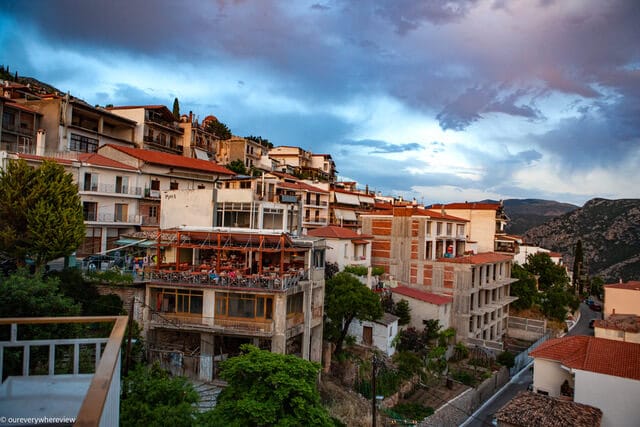
If you are continuing onward by car around mainland Greece, either south toward Olympia or northward to Meteora, Delphi is a good place to spend the night. There is a small selection of hotels for a very decent price. It is a quaint and quiet place for a relaxing evening, to sit on the balcony with a beverage and watch the sun set over the stunning landscape.
What to see in Delphi
Follow the Sacred Way
No, that is not me being glib. Exploring ancient Delphi is pretty straightforward. Just follow the marked Sacred Way and wind your way up the mountain. Be aware, however, that it does require a certain degree of physical fitness. While there are no stairs, it’s a bit of a climb, and we would not consider this path accessible.
There are information plaques all over the site. There are even photos of how the site would have looked in the past. I don’t think you need an extra guide, although the English translation is sometimes a little scrambled, so some additional information is always helpful!
Admire the scenery, soak yourself in the storytelling, marvel at the way the site integrates so seamlessly with the mountainside.
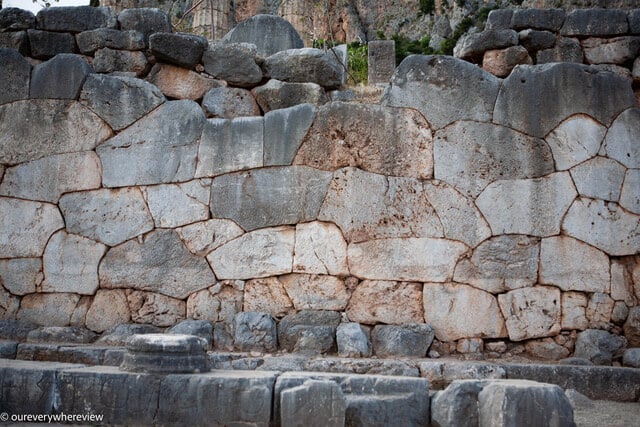

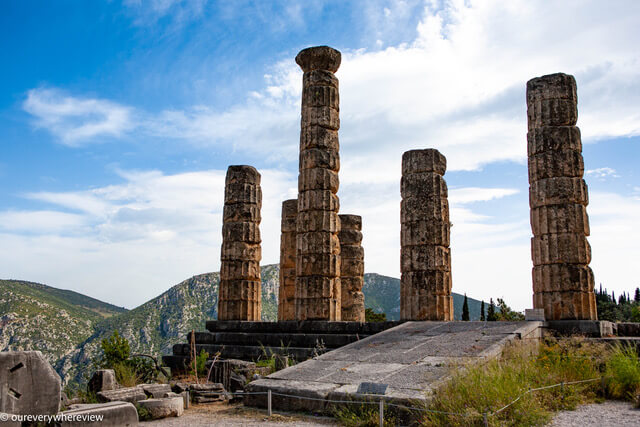
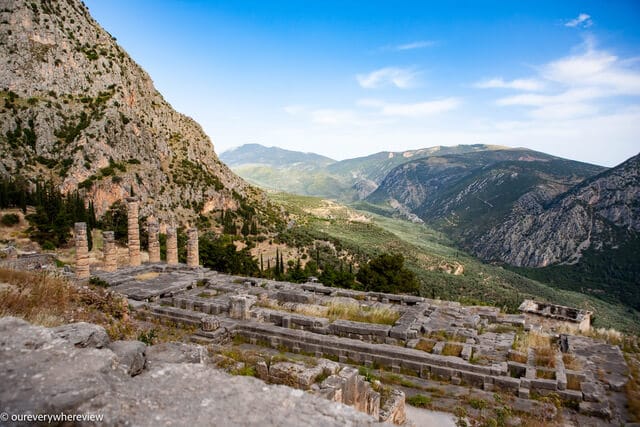
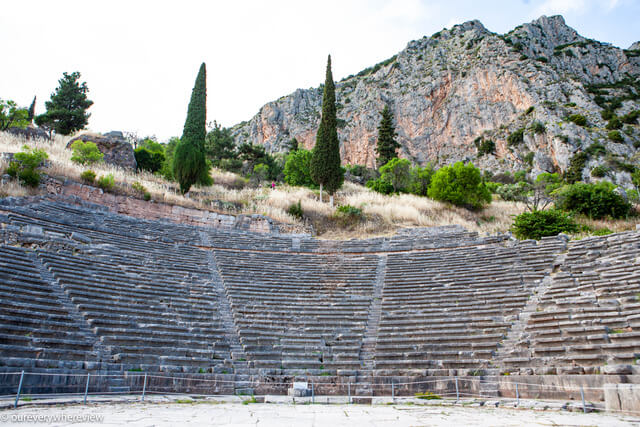
The Stadium
If you have the stamina, the Stadium is a short walk away from the Amphitheater, high in the mountains. The Pythian Games were held here once every four years, to honour Apollo. This was the prelude to the ancient Olympic Games.
The Archeological Museum of Delphi
Every ancient site we visited in Greece had an attached museum of artifacts excavated from the site. The unique thing about Delphi is its vast collection of treasures from all around the world – tokens given by famous rules/states for advice that brought success. (Some were bribes so they could bypass the line to the Oracle.)
The most prominent of the collection is the Charioteer. This bronze statue is one of ancient Greece’s most important figures, which once stood in the Temple of Apollo to honour victors of the Pythian games. The statu is simultaneously victorious yet humble, its proportions strong yet refined. It is thought to symbolize the cusp of classic Western civilization.
The Sanctuary of Athena Pronaia
The Sanctuary of Athena is 1km away from the main site of Delphi. “Pronaia” means “to come before” – this is usually the first stop for pilgrims coming from Athens/the east. (It is still the first stop of visitors coming by tour bus, so try to visit in the afternoon if you can to avoid the crowds.) We walked from the parking lot at the main site, as there’s no dedicated parking lot. It’s possible to park by the side of the road, but it depends on how busy it is. It’s a steep slope from the road down to the site.
The circular tholos of the Sanctuary of Athena has somehow become the postcard shot of Delphi, although it has no direct relation to Apollo’s Oracle. This Sanctuary predates the arrival of Apollo, when the prophetess/priestess worked for Gaia (aka Mother Earth).
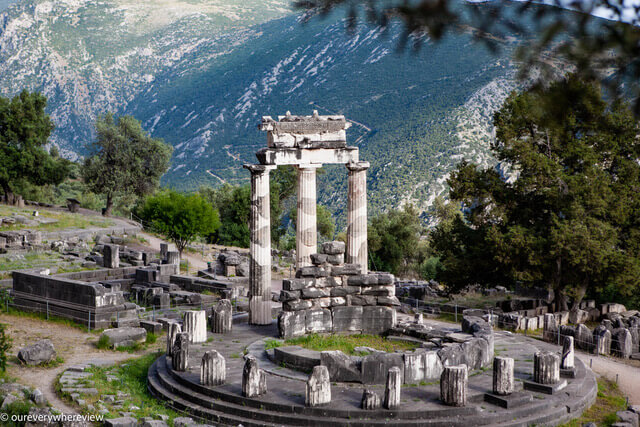
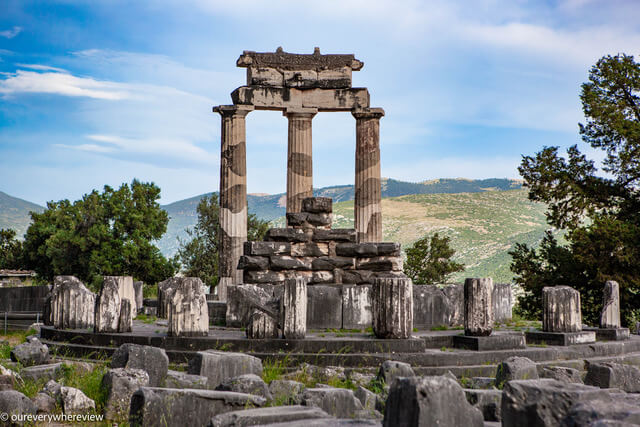
For more of Greece, start here: Greece: two week itinerary




Two weeks in Greece - Itinerary - our everywhere view
[…] Day 5 – Delphi […]
The charming town of Nafplio and the Greek Peloponnese - our everywhere view
[…] Attraction spotlight: Delphi […]
Attraction spotlight: Ancient Olympia - our everywhere view
[…] Attraction spotlight: Delphi […]